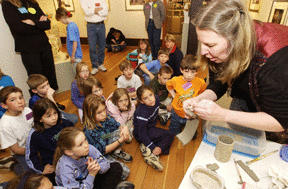The second-grader points at the tall glass vase, his finger missing the vessel by millimeters.
“Wow, that’s really cool,” he says. “Is it stained glass?”
Art teacher Robin Hruska’s maintains her composure.
“No, it’s blown glass; stained glass comes in sheets,” the Blakely Elementary School art specialist says. “Remember to look with your eyes, because there’s lots of art in here.”
There are a lot of second-graders, as well. Teacher Leslie Mirkovich’s visit to the gallery with her students is part of the Arts Consortium program supporting arts education.
The consortium, an alliance of schools, community groups and arts organizations on the island, was recently awarded a fourth year of funding from the Washington State Arts Commission’s Arts in Education Program, which supports programs in local art education.
If energetic, the students are respectful and relatively quiet.
“Bringing the students here has been an experiment to see if we can do this,” BAC publicist Pat Andrews said, “but it’s been positive so far, because Mary Louise Ott and their teachers prepared them well.”
Etiquette
Arts Consortium Coordinator Ott taught the kids what she calls the three rules of gallery etiquette:
Don’t touch, keep voices down, and move through the space with consideration.
“I knew I’d gotten through to them when one kid raised his hand and said, ‘Well, it all comes down to: We need to show respect to the artist,’” Ott said.
The youngsters at BAC, the fourth of six groups in kindergarten through sixth grade to visit, are using a teapot and tea cup show to explore the difference between functional object and fine art.
“The tea pot show is a good venue for the question,” ceramist Debbie Fecher, whose tea cups are in the show, said, “because it makes the kids think, ‘How did all those different artists come up with all those ideas?’”
When Fecher wheels out a small cart laden with art supplies to demonstrate her clay techniques, however, the kids don’t just sit back and watch.
Instead, they engage in a creative exchange with Fecher, who builds teapots cued by ideas the kids suggest.
“They’d give me a theme and I’d elaborate on it. It’s a process that’s kind of like improv,” Fecher said. “You have to think on your feet – but it’s a blast.”
“We want to impress on the kids: Any idea is great as long as it comes from you,” the artist added. “We tell kids: Whatever is your favorite thing, if it’s important to you, then that’s a good place to start.
“So, if you’re into skateboarding, make a teapot with a skateboard theme, or if you love animals, make that the starting place.”
After the students returned to Blakely, they made teapots with Hruska’s help in the art room.
“Before the trip to BAC, they had some trouble moving from sketches in two dimensions to building objects in three.
“This has definitely helped.”



